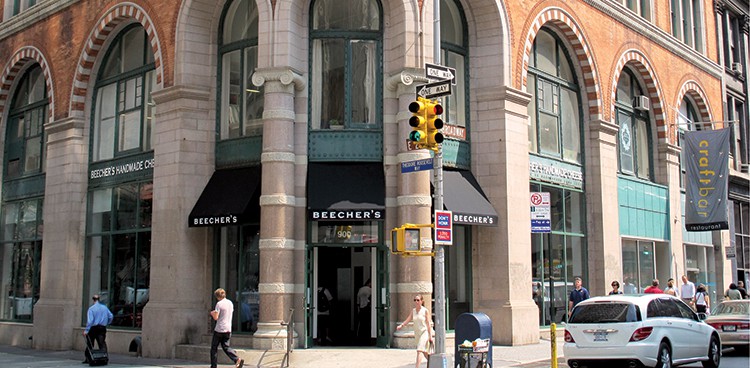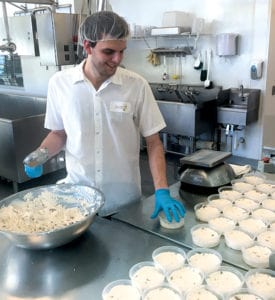
With locations in Seattle’s Pike Place Market and New York City’s Flatiron District, Beecher’s Handmade Cheese is inarguably the most famous urban creamery in the United States. The bicoastal company boasts glass-walled make rooms, inviting consumers to interact and observe. “The big idea for the urban creamery was to show how cheese is made,” says Beecher’s founder Kurt Beecher Dammeier. “[When Beecher’s launched] in 2003, people didn’t have the same sense of curiosity about food that they have now.”
These days, Dammeier says, it’s difficult to choose which American wedges and wheels to stock at the on-site cheese shop (besides his own, of course). It’s a testament to how the artisan cheese community has grown—and with it the capacity for more and more creameries to open within city limits across America. These central settings allow cheesemakers to connect with consumers, serve more restaurants, and keep their fingers on the pulse of the food world. But it isn’t all sunshine and steel vats—urban creameries face a multitude of unique challenges, including a daunting one that plagues all city dwellers: high rent.

Fresh cheese is packaged at Clock Shadow Creamery in Milwaukee, Wis. Photo courtesy of Clock Shadow Creamery
“We can’t afford to use much space for aging cheese, so we concentrate primarily on fresh varieties that we can move quickly,” says Bob Wills, founder of Clock Shadow Creamery in Milwaukee, Wis. Clock Shadow’s chèvre, quark, and fresh curds have all netted awards. Genevieve O’Sullivan, former owner of Washington, D.C.’s Sona Creamery, cites overwhelming overhead as one of the reasons for the company’s 2016 closure. The other? Some serious red tape.
Sona was originally conceived as a simple creamery with a cheese counter and small café, but an ambitious hire convinced O’Sullivan to spring for a full-blown restaurant and wine bar. She rented a 2,500-square-foot space and reserved 1,000 square feet for cheesemaking. The District of Columbia, however, had no formal rules about the production of dairy (since no one had yet attempted it), nor was there a state department of agriculture (as D.C. lacks statehood). So O’Sullivan and her husband, Conan, set out to update the city’s food code while running the wine bar—and their creamery sat idle. The bills piled up; meanwhile, Washington became saturated with dining options—“really good, exciting ones,” says O’Sullivan. “That’s wonderful as a consumer but not for restaurant owners.” Sona did start producing cheese in September 2015, a year and a half after opening, but it wasn’t enough to keep the business afloat.
Despite Sona’s shuttering, O’Sullivan remains positive: “It wasn’t all bad. We met some really great people. I love making cheese . . . we’ve toyed with the idea of getting back into it. We probably wouldn’t have a storefront—that’s where it gets expensive.”
Indeed, not all urban creameries have storefronts. Kristen Schnepp founded London-based Gringa Dairy under a railway arch in 2013 to supply local restaurants and wholesalers with fresh, Mexican-style cheeses. “As an immigrant to the UK from California, I’m passionate about Mexican cuisine improving on these shores,” Schnepp says. “One of the missing puzzle pieces is the supply of goods that require [refrigeration]. It’s expensive to import ingredients with a short shelf life, and tricky laws make it even more economically risky.”
Schnepp saw an opportunity and pounced; today the company turns out queso fresco, queso Chihuahua, and queso Oaxaca and at press time had a cotija in development. “I am proud to be a very small part of the renaissance occurring in the British cheese community,” Schnepp says.
Proximity to the consumer market is also what lured Ancient Heritage Dairy to southeast Portland from rural Salem, Ore. “It’s easier to distribute our product in the city, and we get better exposure to the public,” explains general manager and co-owner Henry Obringer. They couldn’t have chosen a more fitting location—the Weatherly Building, where the creamery is located, was used as a manufacturing facility for ice cream, butter, and cheese in the early 20th century. Unlike Clock Shadow and Gringa Dairy, however, Ancient Heritage focuses on aged cheeses. The creamery’s lineup, established when it was still located in Salem, includes Valentine, a sheep’s milk bloomy rind, and Hannah, a mixed-milk round dotted with protein crystals, both of which took home blue ribbons from the American Cheese Society Judging & Competition.
High rent and taxes, a lack of space, bureaucratic hoop-jumping—it’s all worth it to make “local” more than a marketing term. “Interaction with the public is our main driver,” says Willis of Clock Shadow. “An urban setting gives us improved access to the largest market in the state.”



